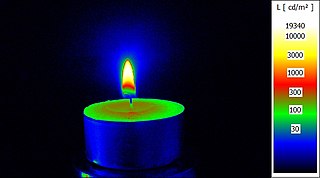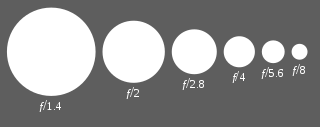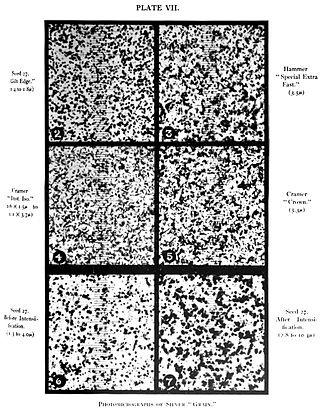
Luminance is a photometric measure of the luminous intensity per unit area of light travelling in a given direction. It describes the amount of light that passes through, is emitted from, or is reflected from a particular area, and falls within a given solid angle.
The focal length of an optical system is a measure of how strongly the system converges or diverges light; it is the inverse of the system's optical power. A positive focal length indicates that a system converges light, while a negative focal length indicates that the system diverges light. A system with a shorter focal length bends the rays more sharply, bringing them to a focus in a shorter distance or diverging them more quickly. For the special case of a thin lens in air, a positive focal length is the distance over which initially collimated (parallel) rays are brought to a focus, or alternatively a negative focal length indicates how far in front of the lens a point source must be located to form a collimated beam. For more general optical systems, the focal length has no intuitive meaning; it is simply the inverse of the system's optical power.

In photography, shutter speed or exposure time is the length of time that the film or digital sensor inside the camera is exposed to light when taking a photograph. The amount of light that reaches the film or image sensor is proportional to the exposure time. 1⁄500 of a second will let half as much light in as 1⁄250.

In photography, exposure is the amount of light per unit area reaching a frame of photographic film or the surface of an electronic image sensor. It is determined by shutter speed, lens F-number, and scene luminance. Exposure is measured in units of lux-seconds, and can be computed from exposure value (EV) and scene luminance in a specified region.

An f-number is a measure of the light-gathering ability of an optical system such as a camera lens. It is calculated by dividing the system's focal length by the diameter of the entrance pupil. The f-number is also known as the focal ratio, f-ratio, or f-stop, and it is key in determining the depth of field, diffraction, and exposure of a photograph. The f-number is dimensionless and is usually expressed using a lower-case hooked f with the format f/N, where N is the f-number.

A light meter is a device used to measure the amount of light. In photography, an exposure meter is a light meter coupled to either a digital or analog calculator which displays the correct shutter speed and f-number for optimum exposure, given a certain lighting situation and film speed. Similarly, exposure meters are also used in the fields of cinematography and scenic design, in order to determine the optimum light level for a scene.

Film speed is the measure of a photographic film's sensitivity to light, determined by sensitometry and measured on various numerical scales, the most recent being the ISO system introduced in 1974. A closely related system, also known as ISO, is used to describe the relationship between exposure and output image lightness in digital cameras. Prior to ISO, the most common systems were ASA in the U.S. and DIN in Europe.

In photography and videography, multi-exposure HDR capture is a technique that creates high dynamic range (HDR) images by taking and combining multiple exposures of the same subject matter at different exposures. Combining multiple images in this way results in an image with a greater dynamic range than what would be possible by taking one single image. The technique can also be used to capture video by taking and combining multiple exposures for each frame of the video. The term "HDR" is used frequently to refer to the process of creating HDR images from multiple exposures. Many smartphones have an automated HDR feature that relies on computational imaging techniques to capture and combine multiple exposures.

In photography, exposure value (EV) is a number that represents a combination of a camera's shutter speed and f-number, such that all combinations that yield the same exposure have the same EV. Exposure value is also used to indicate an interval on the photographic exposure scale, with a difference of 1 EV corresponding to a standard power-of-2 exposure step, commonly referred to as a stop.

In photometry, illuminance is the total luminous flux incident on a surface, per unit area. It is a measure of how much the incident light illuminates the surface, wavelength-weighted by the luminosity function to correlate with human brightness perception. Similarly, luminous emittance is the luminous flux per unit area emitted from a surface. Luminous emittance is also known as luminous exitance.
The Zone System is a photographic technique for determining optimal film exposure and development, formulated by Ansel Adams and Fred Archer. Adams described the Zone System as "[...] not an invention of mine; it is a codification of the principles of sensitometry, worked out by Fred Archer and myself at the Art Center School in Los Angeles, around 1939–40."

In photography, reciprocity is the inverse relationship between the intensity and duration of light that determines the reaction of light-sensitive material. Within a normal exposure range for film stock, for example, the reciprocity law states that the film response will be determined by the total exposure, defined as intensity × time. Therefore, the same response can result from reducing duration and increasing light intensity, and vice versa.

The Pentax Auto 110 and Pentax Auto 110 Super were fully automatic single-lens reflex cameras manufactured by Asahi Pentax for use with Kodak 110 film cartridges. The Auto 110 was introduced with three interchangeable, fixed focal length lenses in 1978. A further three lenses were added in 1981 to coincide with the release of the Auto 110 Super the following year. The camera system was sold until 1985. The complete system is sometimes known as the Pentax System 10, apparently for its official Pentax name, although most Pentax advertising only uses the camera name or Pentax-110. This model represented the only complete ultraminiature SLR system manufactured for the 110 film format, although several fixed-lens 110 SLRs were sold. The camera system also claims to be the smallest interchangeable-lens SLR system ever created.

When setting photoflash exposures, the guide number (GN) of photoflash devices is a measure photographers can use to calculate either the required f‑stop for any given flash-to-subject distance, or the required distance for any given f‑stop. To solve for either of these two variables, one merely divides a device's guide number by the other.

The Bulb setting on camera shutters is a momentary-action mode that holds shutters open for as long as a photographer depresses the shutter-release button. The Bulb setting is distinct from shutter's Time (T) setting, which is an alternate-action mode where the shutter opens when the shutter-release button is pressed and released once, and closes when the button is actuated again.
APEX stands for Additive System of Photographic Exposure, which was proposed in the 1960 ASA standard for monochrome film speed, ASA PH2.5-1960, as a means of simplifying exposure computation.

Film grain or film granularity is the random optical texture of processed photographic film due to the presence of small particles of a metallic silver, or dye clouds, developed from silver halide that have received enough photons. While film grain is a function of such particles it is not the same thing as such. It is an optical effect, the magnitude of which depends on both the film stock and the definition at which it is observed. It can be objectionably noticeable in an over-enlarged film photograph.
Exposure compensation is a technique for adjusting the exposure indicated by a photographic exposure meter, in consideration of factors that may cause the indicated exposure to result in a less-than-optimal image. Factors considered may include unusual lighting distribution, variations within a camera system, filters, non-standard processing, or intended underexposure or overexposure. Cinematographers may also apply exposure compensation for changes in shutter angle or film speed, among other factors.
In the theory of photography, tone reproduction is the mapping of scene luminance and color to print reflectance or display luminance, with the aim of subjectively "properly" reproducing brightness and "brightness differences".

Live preview is a feature that allows a digital camera's display screen to be used as a viewfinder. This provides a means of previewing framing and other exposure before taking the photograph. In most such cameras, the preview is generated by means of continuously and directly projecting the image formed by the lens onto the main image sensor. This in turn feeds the electronic screen with the live preview image. The electronic screen can be either a liquid crystal display (LCD) or an electronic viewfinder (EVF).

















